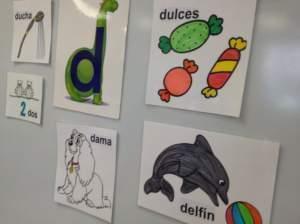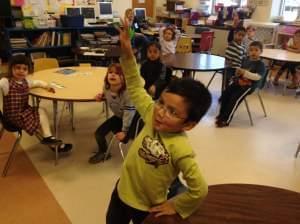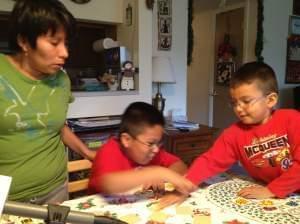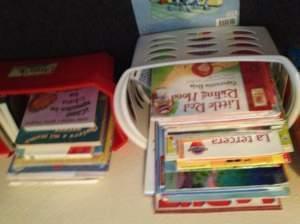With Dual Language, Urbana Seeks to Boost Bilingualism
According to the U.S. Census Bureau, roughly one in five school-age children in the United States speaks a language other than English at home, and most of the time that is Spanish.
Bilingual education has been seen as a way to teach English to kids who are learning it as a second language, but some school districts, including Urbana, are ramping up bilingual education programs to prepare all students to be bilingual and biliterate.
At Urbana’s Leal Elementary School, Kindergarten Teacher Luz Rios goes through a list of phrases and words in Spanish, and her students follow along.
On the surface, this may seem like a typical foreign language class, but it is far from that. Someone could walk in during a math, science, or social studies lesson at any point during the day, and they are likely to hear Spanish.
 Rios is teaching one of the Urbana School District’s newest dual language classes, where her students are about evenly divided between native English and Spanish speakers. The dual language curriculum is new for Urbana students this year.
Rios is teaching one of the Urbana School District’s newest dual language classes, where her students are about evenly divided between native English and Spanish speakers. The dual language curriculum is new for Urbana students this year.
Under the program, kindergarteners are instructed 90 percent of the time in Spanish and 10 percent in English. By fourth and fifth grade, that should level out to about 50-50.
Even when students don’t understand what she was saying, Rios doesn’t revert to English and the students don’t get frustrated. Instead Rios uses other strategies to translate, like drawings or pantomime.
“The objective of this class is not to translate,” Rios said. “Probably later on they will be able to translate things, but it is important that they understand the second language. I don’t want to translate when they don’t understand.”
Right now, the dual language program in Urbana is being piloted in two kindergarten classes and one first grade class - each at Leal and Prairie Elementary Schools.
University of Illinois Professor Eurydice Bauer studies bilingual education and she’s helping out with the dual language program at Prairie. She has organized dual language classes around themes that include hands-on activities. For example, at Prairie she set up lessons about farming.
“I can have you plant seeds, and over time let’s talk about the process of that growth," Bauer explained. "Now, we can have something to talk about, but it’s not just the teacher doing the talking, the kids have something in front of them that is intriguing to them that makes them want to talk and want to explore.”
Bilingual education isn’t a new concept in Illinois. Schools with at least 20 students with Limited English Proficiency who speak the same language are required to offer transitional bilingual education classes to help them adjust to English. Currently, Urbana offers transitional programs to students who speak Spanish and Chinese.
The state currently doesn’t have a standardized test that measures bilingual achievement, but it’s developing one for Kindergarteners and first and second graders.
Josie Yanguas chairs the Illinois Advisory Council on Bilingual Education. She said there are indications of educational benefits for students who learn a second language.
“Students who particularly are in dual language programs when they do take traditional standardized tests seem to be doing so much better than most students who are in more traditional general education English only environments,” Yanguas said.
Guadalupe Ricconi is the Urbana School District’s Interim Director of Bilingual & Multicultural Programs. She said putting test scores aside, learning another language is about comprehending, processing and being able to respond to information.
“So, if the teacher is asking them a question in Spanish, and they’re able to process that and answer – even if that’s in English – that is still showing that they’re learning,” Ricconi said. “That they’re able to understand what the teacher is saying and they’re able to produce a response.”
But much of that work – preparing students to be bilingual and bi-literate – does not just happen in the classroom.
 Ada and Charles Stamper live in Urbana with their two children - Aiden, who’s in Ms. Rios’ kindergarten class at Leal, and Joaquin, who’s a second grader, also at Leal. The Stampers regularly play puzzles and word association games with their kids to continue their bilingual education at home.
Ada and Charles Stamper live in Urbana with their two children - Aiden, who’s in Ms. Rios’ kindergarten class at Leal, and Joaquin, who’s a second grader, also at Leal. The Stampers regularly play puzzles and word association games with their kids to continue their bilingual education at home.
On a recent Saturday morning, the Stampers played a card game with their children that featured different images, like a sun, a car, and a banana.
“Banana, I want banana. Give me a banana. Is that a banana?” Charles said.
“No train,” Aiden said.
At home, Charles only speaks English to his kids, while Ada only speaks Spanish.
A couple of times each week, Ada goes to her kids’ classes to copy the lesson plans, and replicate them at home. They also have their kids read English and Spanish books out loud in the opposite language that the books are written (photo of the books are shown on the right).
 All of this may sound like overkill, but Ada and Charles say they have an important responsibility as parents.
All of this may sound like overkill, but Ada and Charles say they have an important responsibility as parents.
“I’m concerned for my kids,” Ada said. “I’m here. I’m just a housewife. I want that they be professionals. I want that they do something better for their lives, and if I don’t prepare them for the future, who else will do it?”
“I’m learning more about their schools. I love going to their school and watching and paying attention,” Charles added. “They’re teaching us as much as we’re teaching them. I mean, I never imagined having bilingual children.”
Ada is the co-president of Leal’s Parent Teacher Association. She views the dual language program as a major achievement for the area’s growing Latino community.
While the program is helping bring children closer together, she said language and cultural barriers continue do keep some Latino parents from getting involved in the school and connecting with other parents.
“You don’t have to be afraid. You don’t need to speak English,” Ada noted. “You just have to be there and try to be involved with your kid’s family is awesome. Don’t be afraid. Don’t be ashamed. Don’t be embarrassed. You just have to try.”
The Stampers say their main concern is that there are not enough bilingual teachers in Urbana, and that is likely to be an ongoing concern across Illinois.
Over the last five years, the state has cut more than 10 million dollars in bilingual education funding.
Having Spanish-speaking kids learn English is one thing, but it is another thing to have English-speaking kids learn Spanish. That is the quandary facing Daniel Bodony, who is a parent of three students at Leal.
Two of his kids are young enough to be in Leal’s dual language program. He said he fully supports the new curriculum, but still isn’t sure if he will sign his kids up.
“We want to be directly involved with our child's learning,” Bodony said. “Neither of us are Spanish speakers, and that’s part of the barrier. It’s harder for us to be directly involved. We still need to decide if emphasizing dual language upfront or emphasizing one language up front and then looking at second language is preferred, and we really don’t have a good answer for that. ”
As the dual language program expands in Urbana and in other parts of the state, the chair of the Illinois Advisory Council on Bilingual Education says schools shouldn’t make it mandatory, as some students many not be ready for a dual language environment.
